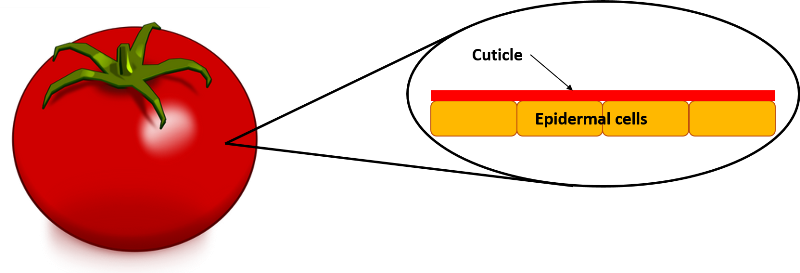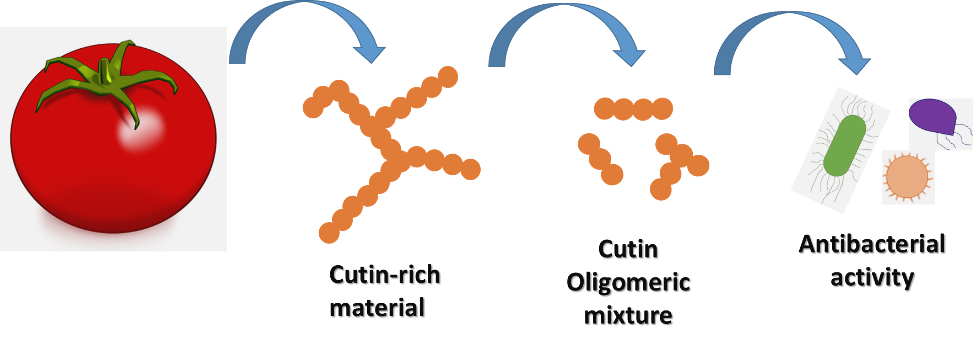Extact of tomato peel against bacteria
We well know that nowadays the demand for food is very high, that is why in food production, in addition to producing the desired product, a large amount of agro-industrial waste and by-products are obtained, which if well considered, can serve for other applications, such as animal consumption or as raw material for other industrial application. And in this regard, in recent years there has been growing interest in the study of agro-industrial residues, since they are a source of various plant polymers and bioactive compounds, particularly cutin is a plant polyester present in the peel of fruits, a part of the fruit very abundant in agro-industrial residues; and thanks to a new study, tomato residues could become raw material for the production of antimicrobial oligomers from cutin-rich materials.

New method converts tomato waste into a source of cutin-rich materials. Source: @emiliomoron, contains public domain image.
According to the article published in the journal ACS Sustainable Chemistry and Engineering, it is mentioned that in 2020 alone almost 10 million tons of tomato were processed in Europe, which generated almost 0.5 million tons of waste, including peels, stems and seeds. And according to the article, a team of researchers from ITQB NOVA and INRAE has demonstrated that it is possible to use this type of waste from tomato fruit to extract bactericidal compounds through a sustainable process.
The peel of the fruit is its armor against external elements, protects it from attack by pathogens, prevents the fruit from injury and water loss, as well as controlling the diffusion of gases and serving as protection against UV radiation. And the cuticle is the outermost layer of this armor, acting as a barrier covering the aerial parts of the upper plants, and its main structural component is cutin.

Cuticle location. Source:@emiliomoron, contains public domain image.
Cutin is a macromolecule composed mainly of ω-hydroxy C16:0 C18:0 acids, generally functionalized, with small amounts of glycerol, phenols and aromatics. It is basically a polymer made up of many long-chain fatty acid molecules held together by ester-like bonds, which allows it to create the basic structure of the cuticle.
On the other hand, the thickness of cutin can vary from 1 to 10 μm, and be present in a proportion that can vary from 40 to 80 wt%, all depending on the species. And although many studies have already explored tomato waste as a source of cutin, these have involved long and complex processes, so this team of scientists sought to simplify the process.
The study established proof of concept for the production of antimicrobial oligomers from tomato waste generated by two agroindustries, isolating cutin-rich materials in a single step. A biodegradable and biocompatible ionic liquid extractor was used to separate the cutin, then the cutin-rich materials were deconstructed by mild hydrolysis, and the product obtained was characterized by nuclear magnetic resonance (NMR) and gas chromatography-mass spectrometry (GC-MS), and evaluated for bactericidal activity against Escherichia coli and Staphylococcus aureus.

Scheme for the production of oligomeric mixtures of bactericidal cutin. Source:@emiliomoron, contains public domain image.
The results of the bactericidal evaluation showed that the extracts possessed antimicrobial activity against bacteria, showing effectiveness against Staphylococcus aureus and Escherichia coli. Although they found differences in effectiveness against E. coli, which may be due to the initial composition of the agro-industrial waste. In the study they argue that the presence of esterified structures that may comprise dioics as construction monomers has an influence on the bactericidal activity against E. coli, but not against S. aureus, so this point requires further study.
However, the method demonstrated that it is possible to use tomato residues to obtain cutin-rich extracts in a simple way, in a single step by means of an ecological extracting agent, obtaining materials with bactericidal activity.
This is undoubtedly an important contribution to the circular use of tomato waste, which could be extended to other fruits, in order to obtain biomaterials of commercial value.
Well friends, I hope you liked the information on this possible application to take advantage of agro-industrial waste, see you next time!
References
Rita Escórcio, Artur Bento, Ana S. Tomé, Vanessa G. Correia, Rúben Rodrigues, Carlos J. S. Moreira, Didier Marion, Bénédicte Bakan, and Cristina Silva Pereira (2022). Finding a Needle in a Haystack: Producing Antimicrobial Cutin-Derived Oligomers from Tomato Pomace. ACS Sustainable Chemistry & Engineering 2022 10 (34), 11415-11427
Tafolla-Arellano, Julio C., González-León, Alberto, Tiznado-Hernández, Martín E., Zacarías García, Lorenzo, & Báez-Sañudo, Reginaldo. (2013). Composición, fisiología y biosíntesis de la cutícula en plantas. Revista fitotecnia mexicana, 36(1), 3-12
Wikipedia.org. Cutin
I love research that is focused in reducing our waste

!1UP
It is very important to give an integral use to all agro-industrial products and to generate as little waste as possible.
You have received a 1UP from @gwajnberg!
@stem-curator, @vyb-curator, @pob-curator
And they will bring !PIZZA 🍕.
Learn more about our delegation service to earn daily rewards. Join the Cartel on Discord.
Thanks!
Thanks for your contribution to the STEMsocial community. Feel free to join us on discord to get to know the rest of us!
Please consider delegating to the @stemsocial account (85% of the curation rewards are returned).
You may also include @stemsocial as a beneficiary of the rewards of this post to get a stronger support.
Thanks my friends!